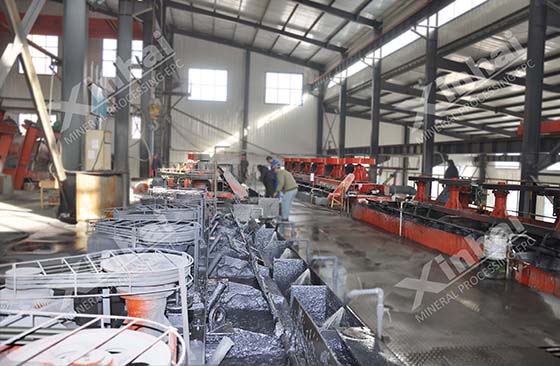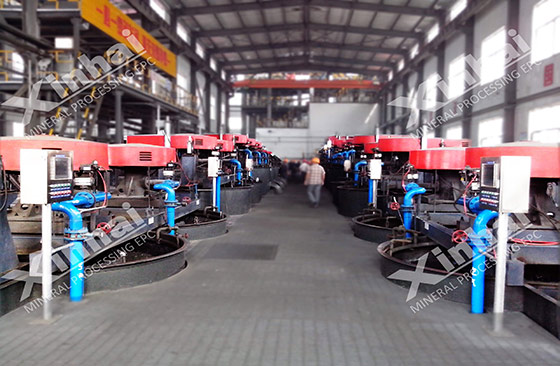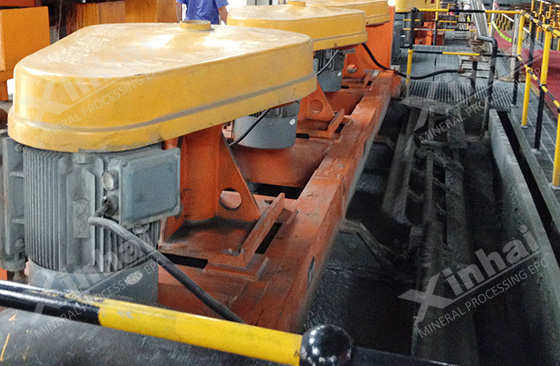
Flotation is an important method of mineral separation, but in actual production, there are many influencing factors. The flotation process is easily affected by the grinding particle size, slurry concentration and temperature. In addition, the flotation time, slurry pH value and slurry stirring and aeration will also affect the mineral flotation effect. The following will introduce to you the effects of flotation time, slurry pH value, slurry stirring and aeration on flotation.

The time that the slurry stays in the flotation tank of each operation is called the flotation time. Each ore has a suitable flotation time, which needs to be determined based on the ore beneficiation test analysis. When the floatability of a mineral is better, the content of floated minerals is smaller. The ore particle size for flotation is appropriate, the slurry concentration is small, the stronger the chemical effect, the stronger the aeration and stirring, the shorter the flotation time.
The flotation time is mainly determined by the floatability of minerals and the quality requirements of the concentrate. For example, graphite flotation requires multiple selections to obtain high-quality concentrate. The time for fine flotation is about 6-10 times that of rough flotation.
The relationship between flotation time and flotation indicators is mainly as follows: increasing flotation time can increase the concentrate recovery rate, but the concentrate grade will decrease. The recovery rate increases rapidly at the beginning of flotation, and gradually becomes slower as time goes by until it no longer increases.

The pH value of the slurry can affect the flotation properties of the mineral surface and various flotation effects. There is a critical pH value when using different flotation reagents for flotation. Controlling the critical pH value can effectively control the sorting of various minerals. Therefore, controlling the pH value of the slurry is one of the important measures in the flotation process.
Most sulfide ores are flotated in alkaline or weakly alkaline slurries. Because acidic slurry has a corrosive effect on flotation equipment, and many flotation chemicals, such as xanthate, oleic acid, pine alcohol oil, etc., are more effective in weakly alkaline slurries.
Aeration mainly sends a certain amount of air into the slurry of the flotation machine, which generates a large number of dispersed micro-bubbles in the slurry so that the hydrophobic mineral particles can adhere to the surface of the bubbles.
The amount of air charged into the slurry is mainly related to the type and working system of the flotation machine. For example, the aeration and stirring of a mechanical agitation flotation machine occur at the same time. The amount of aeration is determined by the speed of the impeller. The faster the impeller rotates, the greater the amount of aeration required. The concentration of the slurry has a great influence on the aeration amount of the flotation machine and the degree of dispersion with air. The degree of air dispersion in the flotation machine slurry also depends on the size of the bubbles. The smaller the bubbles, the better the air dispersion. At the same time, it can increase the bubble surface and the chance of contact with the mineral particles, which is beneficial to improving the flotation index. If the bubbles are too small, it will be harmful to flotation.

Stirring is mainly divided into two stages in the flotation process: stirring before the slurry enters the flotation machine and stirring after the slurry enters the flotation machine.
The stirring before the slurry enters the flotation machine mainly occurs in the stirring tank, in order to accelerate the interaction between the ore particles and the chemicals. The mixing time of the slurry in the mixing tank is determined by the difficulty of dispersing the chemicals in water and the speed of their interaction with the mineral particles. Foaming agents such as pine alcohol oil need to be stirred for 1-2 minutes, and general pharmaceuticals need to be stirred for 5-15 minutes.
The stirring of the slurry after entering the flotation machine has three main functions: one is to promote the suspension of ore particles and even dispersion in the tank; the other is to promote the even distribution of air in the tank, and it can also act as aeration; the third is to promote the air It accelerates dissolution in the high-pressure area of the tank and accelerates precipitation in the low-pressure area, forming a large number of active bubbles.
The aeration and stirring during the flotation process should be determined through mineral processing tests according to the type and structural characteristics of the flotation machine. Strengthening the aeration and stirring of the slurry in the flotation machine is beneficial to flotation but should not be excessive. Excessive stirring and aeration will cause problems such as bubble merger, reduced concentrate quality, reduced slurry volume in the tank, increased power consumption, and mechanical wear.

In addition to the above factors, there are other factors that affect the flotation effect, such as water quality, because flotation is carried out in a water medium, and the gases, ions and certain organic matter contained in the water will affect the flotation process. Therefore, during the flotation process, various factors should be comprehensively considered, and the flotation process and technical parameters should be adjusted in real time according to the actual production situation to avoid affecting the production speed of the overall processing plant and causing economic losses.
To find out more about our products and solutions, please fill out the form below and one of our experts will get back to you shortly.